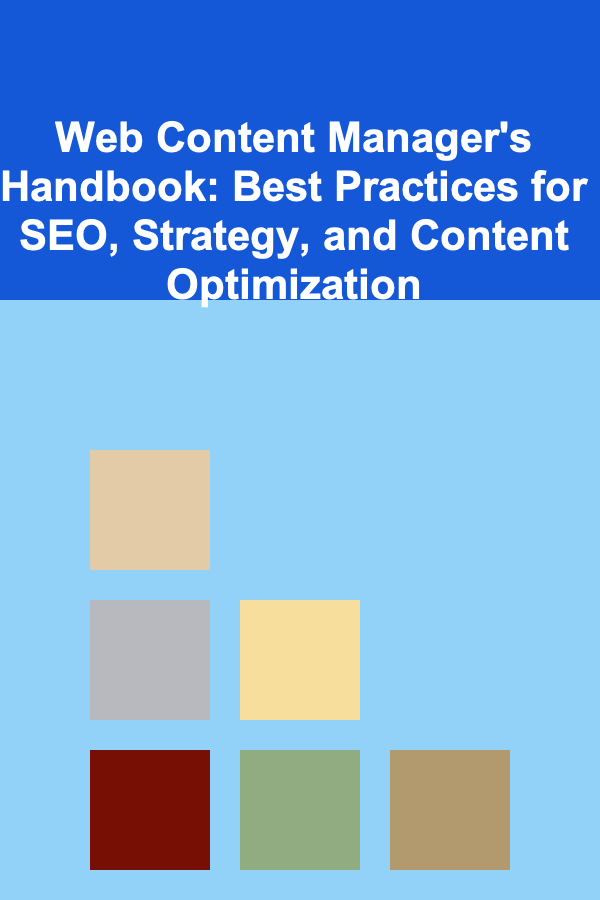
Web Content Manager's Handbook: Best Practices for SEO, Strategy, and Content Optimization
ebook include PDF & Audio bundle (Micro Guide)
$12.99$6.99
Limited Time Offer! Order within the next:

In today's digital world, web content management is more than just posting articles online. It's about crafting a comprehensive strategy that not only attracts visitors but also retains them by providing engaging, useful, and optimized content. As a web content manager, you are at the intersection of creativity, data analysis, and technology. Balancing these elements requires a clear understanding of best practices for SEO, content strategy, and content optimization.
In this actionable guide, we'll explore key principles and techniques that will help you excel in web content management and drive meaningful results for your organization.
Building a Solid Content Strategy
The foundation of any successful web content management process starts with a well-defined content strategy. A good strategy ensures that your content aligns with your business objectives, speaks to your target audience, and drives measurable results. Here's how to build one:
Define Clear Goals
Before creating any content, you must have a clear understanding of what you want to achieve. Are you aiming to increase brand awareness, drive conversions, generate leads, or provide customer support? Setting SMART (Specific, Measurable, Achievable, Relevant, Time-bound) goals will help guide the content creation process and provide metrics for performance evaluation.
Example Goal: Increase website traffic by 20% in the next six months by creating educational blog content targeting long-tail keywords.
Know Your Audience
A well-executed content strategy hinges on knowing your audience intimately. Define your buyer personas, focusing on factors like demographics, interests, pain points, and preferred content consumption methods. Understanding these variables will help ensure that your content resonates with your audience and provides real value.
Actionable Tip:
Conduct surveys, social media polls, or use analytics tools like Google Analytics to gather insights into your audience's behaviors and preferences. The data gathered will inform the types of content and topics to focus on.
Content Pillars and Clusters
A great way to structure your content strategy is through the pillar and cluster model. Content pillars are broad themes related to your business, while clusters are specific subtopics related to those pillars. The cluster model not only improves content organization but also helps with SEO by linking together related content.
Example:
Pillar Topic: "Content Marketing"
Cluster Topics:
- "How to Create a Content Marketing Plan"
- "Content Marketing Metrics You Should Measure"
- "Content Marketing Trends in 2025"
Content Calendar
Consistency is key when it comes to content creation. Having a content calendar in place helps you schedule and organize your content publishing timeline. It ensures that your content strategy remains on track and prevents the last-minute scramble to come up with content ideas.
Actionable Tip:
Use tools like Trello, Asana, or Google Sheets to create a content calendar. Ensure that it includes publication dates, responsible team members, and content deadlines.
SEO Best Practices for Content Managers
Search Engine Optimization (SEO) is one of the most critical aspects of web content management. Without proper SEO, even the best content may remain hidden from your audience. Here are some essential SEO best practices that web content managers should follow.
Keyword Research
The cornerstone of any successful SEO strategy is keyword research. By understanding the search terms your target audience uses, you can tailor your content to meet their needs. Use tools like Google Keyword Planner, SEMrush, and Ahrefs to find high-volume, low-competition keywords that align with your business goals.
Actionable Tip:
Start by finding long-tail keywords that are highly specific and relevant to your content. These keywords are easier to rank for and attract users who are looking for precise information.
On-Page SEO Optimization
On-page SEO involves optimizing individual web pages so that they rank higher on search engines and attract more relevant traffic. Here are some key elements to focus on:
- Title Tags and Meta Descriptions: Ensure that each page has a unique and compelling title tag and meta description. Include your primary keyword naturally while making sure the title entices users to click.
- Headings and Subheadings: Use proper header tags (H1, H2, H3) to organize content. Include keywords in subheadings where it makes sense to help improve SEO and readability.
- Internal Linking: Link to other relevant content within your website to keep users engaged and help search engines understand the structure of your site.
- Image Optimization: Use descriptive file names and alt tags for images, which helps with SEO and accessibility. Additionally, compress images to reduce page load times.
Actionable Tip:
Always check for SEO-friendly URLs. Keep URLs short, descriptive, and keyword-rich. Use hyphens to separate words in the URL.
Mobile Optimization
With the increasing number of users browsing content on mobile devices, it's critical that your website is mobile-friendly. Google also uses mobile-first indexing, meaning that the mobile version of your site is considered the primary version for ranking purposes.
Actionable Tip:
Regularly test your site's mobile-friendliness with Google's Mobile-Friendly Test and optimize design elements such as buttons, fonts, and navigation to improve user experience on smaller screens.
Technical SEO
Technical SEO focuses on the backend aspects of your website that affect its search engine rankings. Key areas to focus on include:
- Page Speed: Google uses page speed as a ranking factor. Use tools like Google PageSpeed Insights to identify ways to improve load times.
- Sitemaps: Ensure that your XML sitemap is updated and submitted to Google Search Console for proper indexing.
- Fix Broken Links: Regularly check for and fix broken links on your website to improve user experience and prevent search engine penalties.
Actionable Tip:
Set up automated monitoring using tools like Screaming Frog to identify and resolve issues like broken links, duplicate content, or slow-loading pages.
Content Optimization for User Engagement
Content optimization goes beyond SEO. It's about improving the quality of your content so that it meets both user expectations and business goals. Here are some content optimization strategies to maximize engagement:
Improve Readability
No matter how well-written your content is, if it's not easy to read, users will quickly leave. Focus on the following elements to enhance readability:
- Short Paragraphs: Break down long paragraphs into shorter chunks to improve readability.
- Bullet Points and Lists: Use bullet points for important information to make your content scannable.
- Clear Call to Action (CTA): Every piece of content should have a clear CTA. Whether it's a newsletter sign-up, product purchase, or download, ensure your readers know what action to take next.
Actionable Tip:
Use readability tools like Hemingway or Grammarly to assess the clarity and readability of your content. Aim for a reading grade level that suits your target audience.
Multimedia Integration
Incorporating multimedia elements such as images, videos, infographics, and interactive content can increase user engagement. Visual content tends to capture attention better than plain text and helps explain complex topics more effectively.
Actionable Tip:
Repurpose written content into engaging videos, infographics, or podcasts to cater to users who prefer alternative content formats. You can also use tools like Lumen5 to turn blog posts into videos.
A/B Testing Content
Testing different content elements can help you understand what resonates most with your audience. A/B testing allows you to test two versions of the same content and see which one performs better in terms of user engagement or conversion.
- Headlines: Experiment with different headline variations to see which one grabs attention more effectively.
- CTA Buttons: Test the design, copy, and placement of CTA buttons to optimize conversion rates.
Actionable Tip:
Use tools like Optimizely or Google Optimize to perform A/B testing on landing pages, blog posts, or even email campaigns. Continuously refine your content based on test results.
Measuring and Analyzing Content Performance
Tracking content performance is essential to understanding whether your strategies are working and where improvements are needed. Here's how you can measure and analyze the effectiveness of your content.
Google Analytics
Google Analytics is a powerful tool for tracking various metrics like page views, bounce rates, time on page, and user flow. By monitoring these metrics, you can identify high-performing content and areas that need improvement.
Actionable Tip:
Set up custom dashboards in Google Analytics to monitor key metrics that align with your content goals. Regularly review these dashboards to assess content performance.
Conversion Tracking
Tracking conversions (whether they're product purchases, form submissions, or downloads) is essential for measuring the success of your content. Set up conversion goals in Google Analytics to see how content influences user actions.
Social Media Analytics
If you're sharing content on social media, use analytics tools built into platforms like Facebook, Twitter, and LinkedIn to track engagement levels, shares, and clicks. This data can give you insight into how your content is resonating with your social media audience.
Conclusion
Effective web content management requires a blend of strategy, technical expertise, and creativity. By focusing on SEO best practices, crafting a robust content strategy, and continuously optimizing content for user engagement, web content managers can ensure that their content reaches the right audience and drives meaningful results. Remember, content management is an ongoing process that requires regular testing, refinement, and staying updated with new trends and technologies. By following the best practices outlined in this guide, you can stay ahead of the curve and successfully manage your web content.

How to Layer Lighting for Maximum Effect in Your Bedroom
Read More
How to Store Books in Style and Function
Read More
How To Reduce Your Insurance Premiums
Read More
How To Master Bass Guitar for Beginners
Read More
How to Use Robo-Advisors for Investing
Read More
How to Teach a Child to Solve the Rubik's Cube
Read MoreOther Products

How to Layer Lighting for Maximum Effect in Your Bedroom
Read More
How to Store Books in Style and Function
Read More
How To Reduce Your Insurance Premiums
Read More
How To Master Bass Guitar for Beginners
Read More
How to Use Robo-Advisors for Investing
Read More